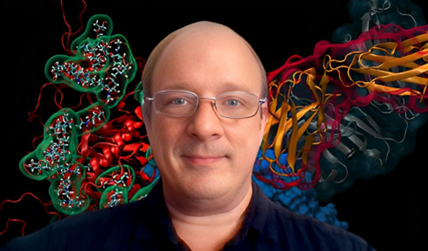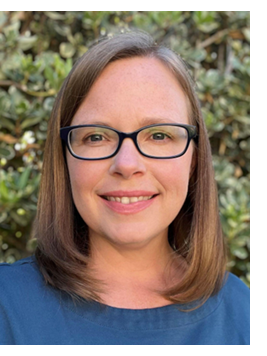Every medicine in your local pharmacy has taken its own unique path to the shelf. From discovery and testing to manufacturing, a new tool is rapidly transforming those pathways: artificial intelligence (AI). And it’s not just hypothetical. AI is already tackling problems in biotechnology—in some cases, problems that were previously unsolvable.
At Amgen, Chris Langmead and Marissa Mock work together with their teams on generative biology—an iterative process between AI-driven machine learning models and leading-edge wet lab research. While the biotech industry has been using data science tools for many years, a combination of faster computing power, powerful DNA sequencing technology, and new AI-driven models is leading to new possibilities.
 “These are not new ideas,” says Langmead, a computer scientist. “What's new is that the machine learning models are powerful enough to really get us to the next level. And what I have found is that you need a combined expertise of not just the clever algorithms and fancy machine-learning techniques, but really, the expertise of the wet lab scientists to make sure you are focusing on the real problem, not the kind of abstract problem that we computer scientists tend to gravitate towards.”
“These are not new ideas,” says Langmead, a computer scientist. “What's new is that the machine learning models are powerful enough to really get us to the next level. And what I have found is that you need a combined expertise of not just the clever algorithms and fancy machine-learning techniques, but really, the expertise of the wet lab scientists to make sure you are focusing on the real problem, not the kind of abstract problem that we computer scientists tend to gravitate towards.”
Mock points to a recent antibody discovery as an example of this real-world problem-solving enabled by AI development. The research team had identified a protein that could potentially be effective against its target, but there was a problem: “It worked really well in terms of the biological function. But it wasn't going to be manufacturable,” Mock explains. “We weren't going to be able to make large quantities of it and put it in a vial and have it sit on a shelf and deliver it to patients, which is a critical part of the process.”
Using their generative biology process, the Amgen teams were able to model the antibody protein with mutations that would enable it to be manufactured. “And it would not have been something that a human would have been able to design without going through many many rounds,” Mock says. “Three years ago, we would just not have tried. That problem was not something that we thought was tractable within reasonable timelines. And that antibody is now moving forward as a potential drug candidate for patients.”
Therein, Mock and Langmead say, lies the power of AI in the drug-discovery process. The AI-driven models both take in data on protein sequences from the lab and create new data on the sequences for the lab to test, in an iterative process that continues to create more powerful models and more robust proteins.
The work of Langmead’s team on the computer science side is about 70 percent technological development and 30 percent drug discovery, but he says he anticipates those numbers flipping quickly. A former professor at Carnegie Mellon University, Langmead has been working on generative models in biotechnology for more than 25 years.
His interest in science began at a young age, with early inspirations from scientists like Jane Goodall. At the same time, he had a deep interest in music, attending a conservatory for college, where he learned how to compose music with computers—his first generative models, but of music, not proteins. Ultimately, Langmead went back to school to get a PhD in computer science, where he worked with a roboticist who was interested in solving problems in protein design.
The technological developments over the past two decades have enabled his work to move out of academia and theory and into the lab and industry, in part through work out of Google DeepMind and others. “Right now is a really exciting time because we have all the factors in place to make very rapid progress,” Langmead says. “We are building the plane as we fly it because there are no off-the-shelf or commercial solutions for addressing the specific problems and challenges we work with.”
Langmead can even envision a future in which the iterative process is more fully automated, with the computer models interacting directly with robots that are producing the proteins to create a continuous cycle—thus freeing up scientists’ time for more creative work. Already, robots are transforming the lab, giving researchers more tools for their work. For both Langmead and Mock, this all leads to a bigger “playground” for experimentation, Mock says.
 A chemist by training, Mock remembers as a child creating her own experiments in the backyard. “I always took everything apart and mixed everything together to see what happened. And so it's kind of amazing to me that I get to get paid to continue to do that—to ‘play’ in the lab.”
A chemist by training, Mock remembers as a child creating her own experiments in the backyard. “I always took everything apart and mixed everything together to see what happened. And so it's kind of amazing to me that I get to get paid to continue to do that—to ‘play’ in the lab.”
On the wet lab side, she thinks of her job as a cook, trying new recipes, now informed by AI models. But it’s not just the models and computers that have changed, Mock emphasizes. Gone are the days of scientists having to pour their own gels to read off the DNA sequencing bands (unless you are learning in an ABE classroom!). Modern DNA sequencing technology allows for rapid creation and testing of proteins.
“The technology platforms are advancing in parallel with new data science platforms, our new understanding of life science, and our ability to make recombinant proteins in pretty robust and amazing ways,” she says. “All of that is converging together for this really exciting time where we can do so many more experiments and try so many things that, five years ago, we wouldn't have tackled because it seemed impossible.”
Moving forward, the biotech industry will continue to need researchers from diverse backgrounds who can bridge the gap between AI and biology. That means not only thinking about building a skillset in different disciplines, including chemistry, biology, and computer science, but also broadening views of who can work in computational fields, Mock says, including women and other underrepresented groups. “There is a lot of space,” she says. “We need diversity in viewpoint and scientific approach in order to generate the best outcomes for solving problems that will help patients.”
